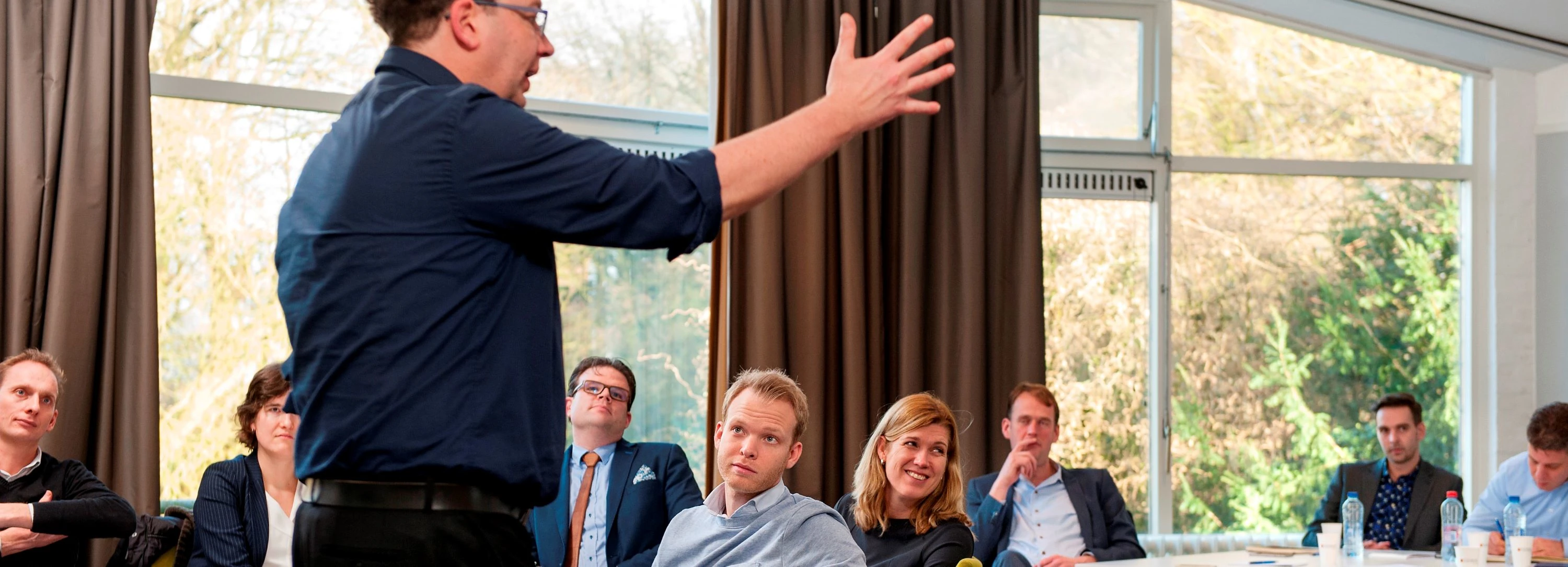Authors: Dr. Ferdy van Beest and Drs. Remko Renes RA
After successful editions in Maastricht, Rotterdam, Tilburg, and Groningen, Nyenrode Business Universiteit hosted the 5th Dutch Accounting Research Conference (DARC) on Monday, June 17, 2019. DARC contributes to the stimulation of scientific research in the broader area of Accounting, including auditing, for scholars in the Netherlands using a one-day conference format. We reflect briefly on the papers presented and the key take aways of this year’s event and provide an insight into current interesting accounting and auditing research in the Netherlands.
The second paper at the DARC conference was presented by Jaeyoon Yu from Erasmus University. It is a joint project with Jaehan Ahn (Northeastern University) and is entitled: Cultural Background of Audit Partners. Their research explores one potential aspect from the large body of individual partner effects discussed in previous audit research. Yu and Ahn follow a growing body of accounting research which investigates the effect of company executivesʼ cultural background on corporate decision-making. The causality issue in this literature stream seems to be of less concern because cultural background is inherited from previous generations. Given the increasing trend toward various ethnicities in the auditing profession, an understanding of the role of audit partners’ cultural background in their behavior is a timely issue. Since DARC participants tend to be constructive, yet critical, the issue on ethnicity raised questions among participants whether we should dive into this very ethical issue. Yu and Ahn identify ethnicities of U.S. audit engagement partners based on their names and examine whether the cultural background of audit partners plays a role in audit processes. They find that audit partners with different ethnicities exhibit distinct auditing style as manifested in going-concern opinions, absolute discretionary accruals, audit delays, and audit fees. Moreover, they find that their results are not driven by cultural ties between CEOs and audit partners (i.e., same ethnicity).
Overall, their findings highlight the significant role of partners’ cultural background in exhibiting discernable differences in their behavior, yet further specification of why and how may further improve this paper. To what extent the individual cultural background of partners is affected by or effects the role of the audit team, office and firm should be further explored.
After the break, Kavita Nandram (PhD candidate at the University of Amsterdam) explored the role of integrated reporting in improving financial reports. More specifically, in a joint project with her promotors Henk Langendijk and Arjan Brouwers, Kavita presented their paper entitled: The Effect of the Degree of Connectivity between Financial and Non-Financial Information in an Integrated Report on Professional and Non-professional Investors’ Firm Valuation Decisions. Starting with a short animation film by the IIRC on integrated reporting, the primary objective of integrated reporting is to improve information for providers of financial capital (IIRC 2013). A distinguishing feature of an integrated report is the connection between non-financial and financial performance indicators. This “connectivity of information”, is seen as a way to report about the extent to which the firm internally thinks and publicly reports in an integrated way and should provide investors and other stakeholders with a better understanding of the organization’s business model. Moreover, Integrated Reporting reduces short-termism among investors. Using an experimental design, the goal of this study is to investigate how different levels of connectivity in an integrated report influence firm valuation decisions of professional and non-professional investors. Nandram hypothesizes that firm valuation is positively associated with a higher level of connectivity in an integrated report. Their results show that a higher level of connectivity in an integrated report has a positive effect on non-professional investors’ firm valuation decisions, but not for professional investors. In terms of suggestions by the DARC participants, a further exploration of theoretical differences on effect between professional and non-professional investors seems useful.
The fourth paper was presented by Wilbert Snoei of the Nyenrode Business Universiteit entitled: Material judgments in materiality determination. It is a joint project with Joost van Buuren and Barbara Majoor working in the Center for Accounting, Auditing & Control. In their exploratory research they try to disentangle the drivers of materiality setting within the audit of financial statements by the financial auditor, since there exists limited archival research on materiality determination. They examine different factors used to determine planning materiality and the tolerable error. Planning materiality should be set by an auditor from a user perspective. Tolerable error is determined for purposes of assessing the risks of material misstatement and for planning of audit procedures. Creating more clarity on the expectations among both concepts was one of the key takeaways for further improving this paper. They use accountability theory as explaining theory for the materiality determination; however, this theory was not always clear in the hypotheses. Their findings are based on a proprietary data set from real audit files gathered by Nyenrode students, working in financial audit. The unique data set comprises 3,180 engagement-year observations from about 800 different engagement clients over the years 2005–2015. Their results show that differences in materiality setting arise between audit firms, where the Big4 audit firms apply the highest levels of materiality. Furthermore, they find that differences in accountability pressure in engagement and audit risk influences materiality setting, and that the client relationship and economic bonding affects the level of materiality.
The final presentation at the DARC conference 2019 was by Eddy Cardinaels, former editor at The Accounting Review and currently appointed as full professor at Tilburg University and KU Leuven. The paper is a joint project with Christoph Feichter (Maastricht University) and is entitled: Forced ranking systems from employee and supervisor perspectives. Many firms use forced ranking systems where supervisors rank employees according to a forced distribution. In this paper they develop theory suggesting that the use of forced rankings - compared to when the supervisor is free to decide about the performance ranks – can be detrimental when supervisors have to assess subjective dimensions of employee performance like creativity, innovation or organizational citizenship; especially when differences between solutions are marginal. They conducted an experiment in which employees have to develop creative solutions for societal problems, and a supervisor is required to rate employees’ performance. Quite innovative was the use of biomarkers in accounting research to measure actual stress levels of participants. One of the suggestions for further exploration by the DARC audience was to what extent this differs from earlier incentives versus punishments literature and the signaling effect in the forced and unforced ranking system. Results show that while forced ranking induces more effort (i.e. time spent), it also creates higher stress levels for employees (i.e., measured via ex-post stress scales and bio-markers; i.e., cortisol measures on stress hormone). Moreover, their results show that the ratings, which the supervisors give to employees, are explained less by the actual creative performance. Instead, aspects such as eloquent writing (i.e., readability indices, complex words), or strategically gaming the system (i.e., intertemporal swapping of ranks) are more important in the forced ranking than under the free ranking system. Their evidence hints at some important detrimental effects of forced ranking systems that can be damaging to companies that rely on more subjective dimensions of employee performance.
Amsterdam
After five years we conclude that DARC stimulates exchange and collaboration between Dutch accounting researchers across universities, besides their increasing contribution to international established research journals. Next years’ conference will be hosted in Amsterdam. We are looking forward to another constructive day and we thank both Maandblad voor Accountancy en Bedrijfseconomie (MAB) as well as the Limperg Institute for their financial contribution making this fruitful knowledge experience possible.This report is also published on MAB-online.nl.
Source: Newsletter Nyenrode Corporate Governance Institute, October 2019.
Related programs
-
Digitalization and Boardroom Dynamics - Modular MBA Elective
Start date: 17 March 2025Language:- English
Location:- Breukelen
The module Digitalization and Boardroom Dynamics looks at technology's effect on the board. Part of the Modular Executive MBA Business & IT.
View program
-
Government and Corporate Governance
Start date: Start Autumn, 2023Language:- Dutch
Location:- Breukelen
This module is only given in Dutch. Please visit our Dutch site.
View program

